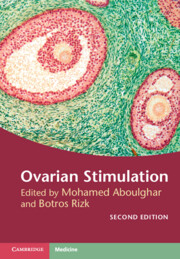Book contents
- Ovarian Stimulation
- Ovarian Stimulation
- Copyright page
- Dedication
- Contents
- Contributors
- About the Editors
- Foreword
- Preface to the first edition
- Preface to the second edition
- Section 1 Mild Forms of Ovarian Stimulation
- Chapter 1 Oral Agents for Ovarian Stimulation
- Chapter 2 Ovulation Induction for Anovulatory Patients
- Chapter 3 Ovarian Hyperstimulation in Combination with Intrauterine Insemination
- Chapter 4 Mild Approaches in Ovarian Stimulation
- Chapter 5 The Case against Mild Stimulation Protocols
- Section 2 Ovarian Hyperstimulation for IVF
- Section 3 Difficulties and Complications of Ovarian Stimulation and Implantation
- Section 4 Non-conventional Forms Used during Ovarian Stimulation
- Section 5 Alternatives to Ovarian Hyperstimulation and Delayed Transfer
- Section 6 Procedures before, during, and after Ovarian Stimulation
- Index
- References
Chapter 4 - Mild Approaches in Ovarian Stimulation
from Section 1 - Mild Forms of Ovarian Stimulation
Published online by Cambridge University Press: 14 April 2022
- Ovarian Stimulation
- Ovarian Stimulation
- Copyright page
- Dedication
- Contents
- Contributors
- About the Editors
- Foreword
- Preface to the first edition
- Preface to the second edition
- Section 1 Mild Forms of Ovarian Stimulation
- Chapter 1 Oral Agents for Ovarian Stimulation
- Chapter 2 Ovulation Induction for Anovulatory Patients
- Chapter 3 Ovarian Hyperstimulation in Combination with Intrauterine Insemination
- Chapter 4 Mild Approaches in Ovarian Stimulation
- Chapter 5 The Case against Mild Stimulation Protocols
- Section 2 Ovarian Hyperstimulation for IVF
- Section 3 Difficulties and Complications of Ovarian Stimulation and Implantation
- Section 4 Non-conventional Forms Used during Ovarian Stimulation
- Section 5 Alternatives to Ovarian Hyperstimulation and Delayed Transfer
- Section 6 Procedures before, during, and after Ovarian Stimulation
- Index
- References
Summary
Conventional ovarian stimulation protocols intend to yield as many oocytes and embryos as possible to try to maximize the success of an in vitro fertilization (IVF) program. In reality, however, a series of studies over the last few years observed that live birth rates (LBRs) do not increase after a certain number of retrieved oocytes [1–3]; some studies even found a decline in LBRs when the number of oocytes was in excess of 18 [4] or blastocyst numbers above 5 [5]. Although the cumulative LBR keeps rising over and above the number of oocytes/embryos that maximizes per cycle live birth, the incidence of ovarian hyperstimulation syndrome (OHSS) and venous thromboembolism (VTE) also escalate in a parallel fashion [2;3;6]. A recent study, by restricting the stimulation dose to 150 IU/day, found only nine oocytes or four embryos optimizing the fresh cycle LBR [7].
- Type
- Chapter
- Information
- Ovarian Stimulation , pp. 36 - 46Publisher: Cambridge University PressPrint publication year: 2022



